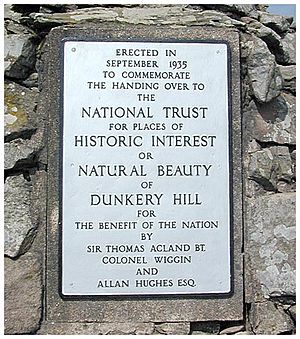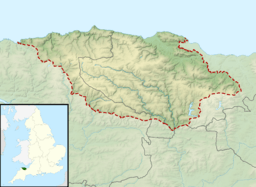Dunkery Hill facts for kids
Quick facts for kids Dunkery Hill |
|
|---|---|
Dunkery Beacon seen on the
ascent up the western slopes |
|
| Highest point | |
| Elevation | 1,705 ft (520 m) |
| Prominence | 414 m (1,358 ft) |
| Parent peak | High Willhays |
| Listing | Marilyn, County Top |
| Geography | |
| OS grid | SS891415 |
| Topo map | OS Landranger 181 |
Dunkery Beacon is the highest point on Dunkery Hill. It is found in Exmoor and is the tallest spot in Somerset, England. It's also the highest point in southern England, except for places in Dartmoor.
This tall hill is made of sandstone. It reaches about 520 meters (1,705 feet) high. From its top, you can see amazing views. You can spot the surrounding moorland, the Bristol Channel, and even hills up to 138 kilometers (86 miles) away!
People have visited this spot for a very long time, since the Bronze Age. You can still see ancient burial mounds here. These are called cairns and bowl barrows. On the lower slopes, there are remains of Iron Age hill forts. There's also a medieval village that was abandoned long ago.
Dunkery Hill is a special place for nature. It is part of a Site of Special Scientific Interest and a National Nature Reserve. For many years, it was owned by private people. But in the 20th century, it was given to the National Trust. A stone cairn was built at the top to remember this gift.
Where is Dunkery Hill?
Dunkery Hill is made of sedimentary rock. This rock formed during the Middle Devonian period. The soil on the hill is quite acidic.
The ridge along the top of the hill is about 4.5 kilometers (2.8 miles) long. Dunkery Beacon is 520 meters (1,705 feet) above sea level. This makes it the highest natural point in Somerset.
Dunkery is known as a "Marilyn". This means it's a peak with at least 150 meters (492 feet) of relative height. The closest higher hill is Yes Tor, which is about 60 kilometers (37 miles) away. In the old novel Lorna Doone, a character calls it the "haighest place of Hexmoor."
Dunkery is only about 6.4 kilometers (4 miles) from the Bristol Channel at Porlock. The quickest way to climb it is from the Dunkery Gate car park. This path is only about 1.2 kilometers (0.75 miles) long.
From the top, you can see far and wide. You might spot the coasts of the Bristol Channel and the English Channel. You can also see the Brecon Beacons in Wales, including Pen y Fan. Even Bodmin Moor, Dartmoor, the Severn Bridges, and Cleeve Hill in Gloucestershire (138 kilometers or 86 miles away) can be seen on a clear day.
History of Dunkery Hill
Dunkery Hill was once part of the "Royal Forest of Exmoor." This forest was created by King Henry II a long time ago. The name "Dunkery" might come from old Welsh words. Some think it means "hillfort rock."
There are several Bronze Age burial mounds near the summit. Two of the biggest are called Joaney How and Robin How. These have been damaged over time, but there are plans to fix them. The word "How" comes from an old Norse word for a burial mound. Joaney How is over 22 meters (72 feet) wide.
On the southeastern slopes, you can find more cairns. There are also barrows from the Bronze Age. One bowl barrow is 12.3 meters (40 feet) wide. A circular stone mound, about 1.5 meters (5 feet) high and 14 meters (46 feet) wide, is also nearby. It dates back to the Neolithic or Bronze Age.

Sweetworthy is on the north side of Dunkery Hill. Here, you can find two Iron Age hill forts. One of these has a single wall and a ditch. It covers about 0.25 hectares (0.62 acres). The old wall is still visible today. Sweetworthy is also the site of a deserted medieval village. This site is now an ancient monument.
In 1918, Sir Thomas Acland gave a long lease of a large part of the Holnicote Estate to the National Trust. This included Dunkery Hill. In 1928, Dunkery Hill was put up for sale. A politician named Margaret Bondfield asked if the government could protect it as an ancient monument. The government agreed to list it, but they didn't have money to buy it.
Later, in 1932, Colonel W.W. Wiggin donated the beacon and 960 acres (388 hectares) of land around it. In 1934, Mrs. Hughes gave another 945 acres (382 hectares) in memory of her husband. These gifts were celebrated in 1935. A plaque was placed on the summit memorial cairn to remember these important donations.
Nature and Wildlife
Dunkery Hill is a very important place for nature. It is part of the North Exmoor Site of Special Scientific Interest. It's also part of the Dunkery & Horner Woods National Nature Reserve. Plus, it's part of the Exmoor Coastal Heaths Special Area of Conservation.
The hill is covered in heather. This plant makes the hill look a deep purple color in the summer. Other plants like ling, bell heather, gorse, and bracken grow here. You can also find sessile oak, ash, rowan, and hazel trees. Many types of moss, liverworts, lichens, and ferns thrive here too. There are even some unique whitebeam tree species.
Many animals live on or around the hill. You might see Exmoor ponies and red deer. Birds like pied flycatchers, wood warblers, lesser spotted woodpeckers, and redstarts are common. You might also spot dippers, snipe, skylarks, and kestrels. Horner Woods nearby is home to 14 of the 16 types of bats found in the UK. This includes rare bats like the barbastelle and Bechstein's bats.


